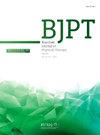与患有髌骨关节炎的男性和未患有髌骨关节炎的女性相比,患有髌骨关节炎的女性的行走生物力学存在差异。
IF 3.1
3区 医学
Q1 ORTHOPEDICS
引用次数: 0
摘要
背景:患有髌骨关节(PF)骨关节炎(OA)的女性和男性在行走生物力学方面的差异可能会导致PFJ OA患者持续症状的出现或恶化:评估患有 PF OA 的女性在行走生物力学方面与(i) 患有 PFJ OA 的男性和(ii) 未患 PF OA 的女性有何不同。其次,探讨膝关节相关症状/功能与 PF OA 患者行走生物力学之间的关系,以及这些关系是否因性别而改变:方法:纳入 67 名 PF OA 患者(43 名女性)和 14 名无 PF OA 的女性。在行走过程中记录生物力学数据。使用膝关节损伤和骨关节炎结果评分法获得患者报告的症状和功能。连续生物力学数据的差异使用统计参数图进行评估,离散数据和关系使用线性模型进行评估:结果:患有 PF OA 的女性在整个站立过程中行走时髋关节内收角度较大(t > 2.757),髋关节屈曲、膝关节屈曲和踝关节背屈力矩的脉冲较低(调整后的平均差异[95 % CI]:3.3 × 10-2 [-4.9 × 10-2, -1.6 × 10-2], -2.9 × 10-2 [-5.3 × 10-2, -0.4 × 10-2], -5.1 × 10-2 [-8.2 × 10-2, -2.0 × 10-2] Nms/kg)。与无症状的同龄人相比,PF OA 女性患者的髋关节屈曲度偏移了 5°。较高的膝关节内收力矩脉冲与男性患者较差的KOOS-ADL评分相关,而与女性患者无关:结论:观察到的生物力学差异较小,与 KOOS 的关系中度至微弱。研究结果并不局限于膝关节,这表明患有 PF OA 的女性在整个运动链中表现出独特的生物力学特征。本文章由计算机程序翻译,如有差异,请以英文原文为准。
Walking biomechanics in women with patellofemoral osteoarthritis differ compared to men with and women without patellofemoral osteoarthritis
Background
Differences in walking biomechanics between women and men with patellofemoral joint (PF) osteoarthritis (OA) may contribute to the development or progression of persistent symptoms in people with PFJ OA.
Objective
Evaluate how walking biomechanics of women with PF OA differ from: (i) men with PFJ OA; and (ii) women without PF OA. Second, explore the relationship between knee-related symptoms/function and walking biomechanics in individuals with PF OA, and whether these are modified by sex.
Methods
Sixty-seven individuals with PF OA (43 women) and 14 women without PF OA were included. Biomechanics data were recorded during walking. Patient-reported symptoms and function were obtained using the Knee injury and Osteoarthritis Outcome Score. Differences in continuous biomechanical data were assessed using statistical parametric mapping, with discrete data and relationships evaluated using linear models.
Results
Women with PF OA walked with a greater hip adduction angle throughout stance (t > 2.757) and lower impulses for the hip flexion, knee flexion, and ankle dorsiflexion moments (adjusted mean differences [95 % CI]:3.3 × 10–2 [-4.9 × 10–2, -1.6 × 10–2], -2.9 × 10–2 [-5.3 × 10–2, -0.4 × 10–2], -5.1 × 10–2 [-8.2 × 10–2, -2.0 × 10–2] Nms/kg, respectively) compared to men with PF OA. Compared to their asymptomatic peers, women with PF OA displayed a 5° offset towards greater hip flexion. Higher knee adduction moment impulse correlated with worse KOOS-ADL scores in men, not women.
Conclusion
Observed biomechanical differences were small in nature with moderate to weak relationship observed with the KOOS. Findings were not limited to the knee, indicating that women with PF OA display unique biomechanical features across the kinetic-chain.
求助全文
通过发布文献求助,成功后即可免费获取论文全文。
去求助
来源期刊
CiteScore
6.10
自引率
8.80%
发文量
53
审稿时长
74 days
期刊介绍:
The Brazilian Journal of Physical Therapy (BJPT) is the official publication of the Brazilian Society of Physical Therapy Research and Graduate Studies (ABRAPG-Ft). It publishes original research articles on topics related to the areas of physical therapy and rehabilitation sciences, including clinical, basic or applied studies on the assessment, prevention, and treatment of movement disorders.

 求助内容:
求助内容: 应助结果提醒方式:
应助结果提醒方式:


